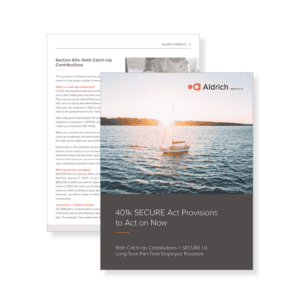Fidelity Bonds and Fiduciary Insurance: What’s the Difference?
There is often confusion surrounding the topic of fidelity bonds and fiduciary insurance. What’s the difference? Why is it important? Which is required? Who is protected? How can each be paid for?
ERISA fiduciaries are personally liable for any losses incurred by the plan due to a fiduciary breach. Consider the dollar value of assets in your plan and the degree of your personal liability. How do you protect yourself and the plan participants from losses due to fraud or dishonesty?
What exactly is a fidelity bond?
ERISA requires plans to have a fidelity bond (also referred to as a fiduciary bond) covering every person who handles funds or other property of such plan. The purpose of ERISA’s bonding requirement is to protect the plan against loss due to fraud or dishonesty by plan fiduciaries and others who handle plan funds, whether directly or through cooperation with others.
A plan fiduciary or other person is considered to handle plan funds if the person has physical contact with cash, checks or other similar property, is able to secure physical possession of plan funds or has the potential ability to transfer plan funds to themselves or third parties. The fidelity bond needs to cover all fiduciaries and anyone who has actual authority over plan assets. The responsibility for calculating contributions or working on the payroll does not rise to the level of handling plan assets unless the person has the authority to cut the check and remit it to the trust.
The amount of the bond coverage is determined by plan assets at the beginning of the year and reported annually on the plan’s form 5500. Therefore, if a plan reports insufficient bonding relative to plan assets, it could increase the likelihood of prompting an IRS audit. The plan is required to have a bond for at least 10 percent of the amount of plan assets but generally no less than $1,000 and no more than $500,000 (unless the plan holds company stock). If your plan is under the $500,000 maximum, be sure to review your plan’s coverage on an annual basis to determine if it meets ERISA coverage requirements. Small plans (typically those with under 100 participants) that hold certain types of non-qualifying plan assets, such as real estate, may require higher bonding amounts in order to continue operating without requiring an annual plan audit.
The bond must be obtained from an approved corporate surety company. The bond cannot be obtained from a surety company in which the plan (or a party-in-interest to the plan) has any direct or indirect control or significant financial interest.
So what does your fidelity bond buy you? If you are at the maximum coverage, it provides insurance against $500,000 of losses caused by one of the covered persons due to fraud or dishonesty. But what if your loss or embezzlement exceeds $500,000? If you are a fiduciary, you may be personally liable for all or part of that loss to plan participants.
What is the difference between a fidelity bond and fiduciary insurance?
This is where fiduciary liability insurance comes into play. Where the ERISA fidelity bond protects the plan against certain losses, fiduciary liability insurance protects plan fiduciaries from losses incurred in their role but generally not from losses caused by fraud or dishonesty. The purpose of the fiduciary liability coverage is to cover honest fiduciaries who still may be liable to participants for plan losses.
Several companies offer fiduciary liability insurance designed to cover claims for breaches of fiduciary duty. The coverage and policy features vary widely by policy. The employee or fiduciary usually purchases the insurance for himself or has the sponsoring employer pay for the coverage to avoid any suggestion of a prohibited transaction (i.e., the plan paying to protect its own fiduciaries).
Items to Consider
Other items to consider when looking at fiduciary liability coverage are annual premium cost, amount of coverage necessary, the amount of the deductible and when it is charged (at the time of claim or at the time of settlement), and whether attorney’s fees and costs of defending a claim are covered. Some providers will also offer a discount on premium costs if evidence can be produced which shows that the fiduciaries have attended formal training (such as our annual fiduciary trainings).
ERISA fidelity bond coverage is required to protect the plan, but you may want to also consider some form of fiduciary liability insurance to protect your key executives who are acting in a fiduciary capacity with respect to the plan. Remember, while the fidelity bond expenses can be paid from plan assets, this is typically not the case when it comes to paying for fiduciary liability insurance.
Meet the Author
Neil is a Certified Plan Fiduciary Advisor (CPFATM) and Accredited Investment Fiduciary (AIF®) who acts as the quarterback of a retirement plan. He guides employers through the overall plan management with the knowledge to do a deep dive into any aspect of plan operation. Neil connects the dots between internal staff and external service providers…
Neil's EXPERTISE
- Corporate retirement plans
- Recordkeeper selection
- Strategic planning and consultation
- One-to-one consulting participant meetings
- Certified Plan Fiduciary Advisor (CPFATM)
- Accredited Investment Fiduciary (AIF®)

